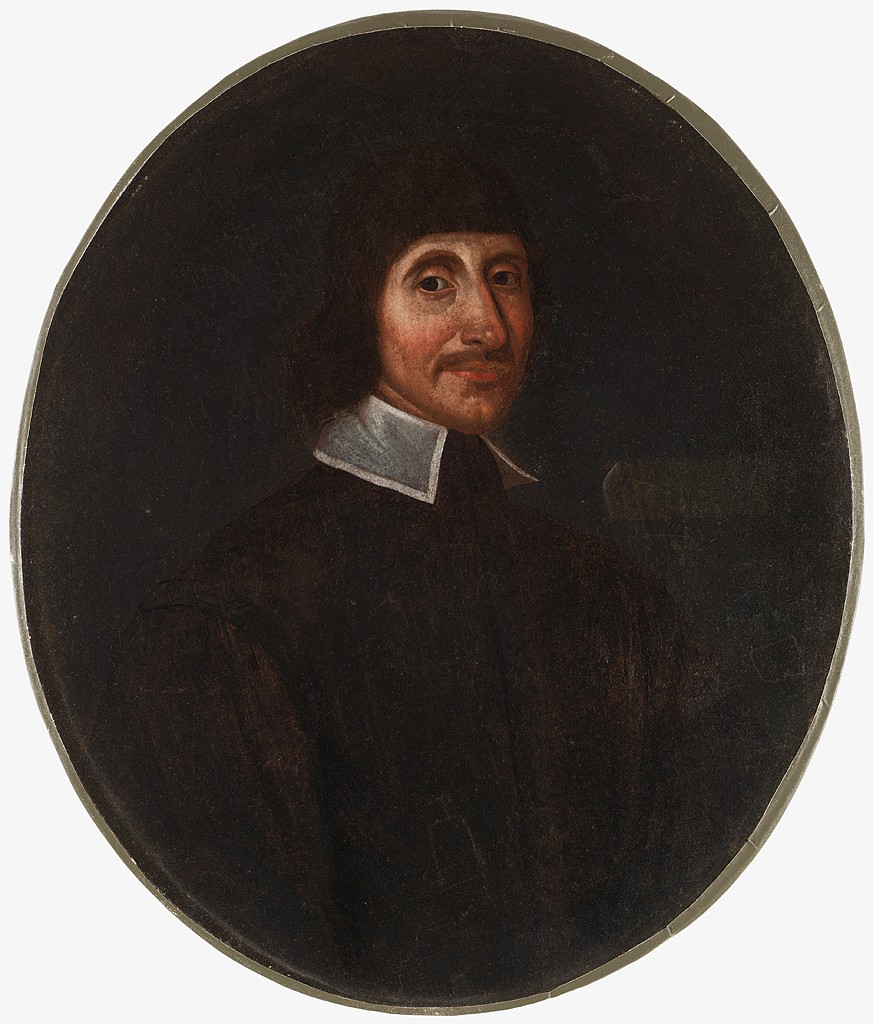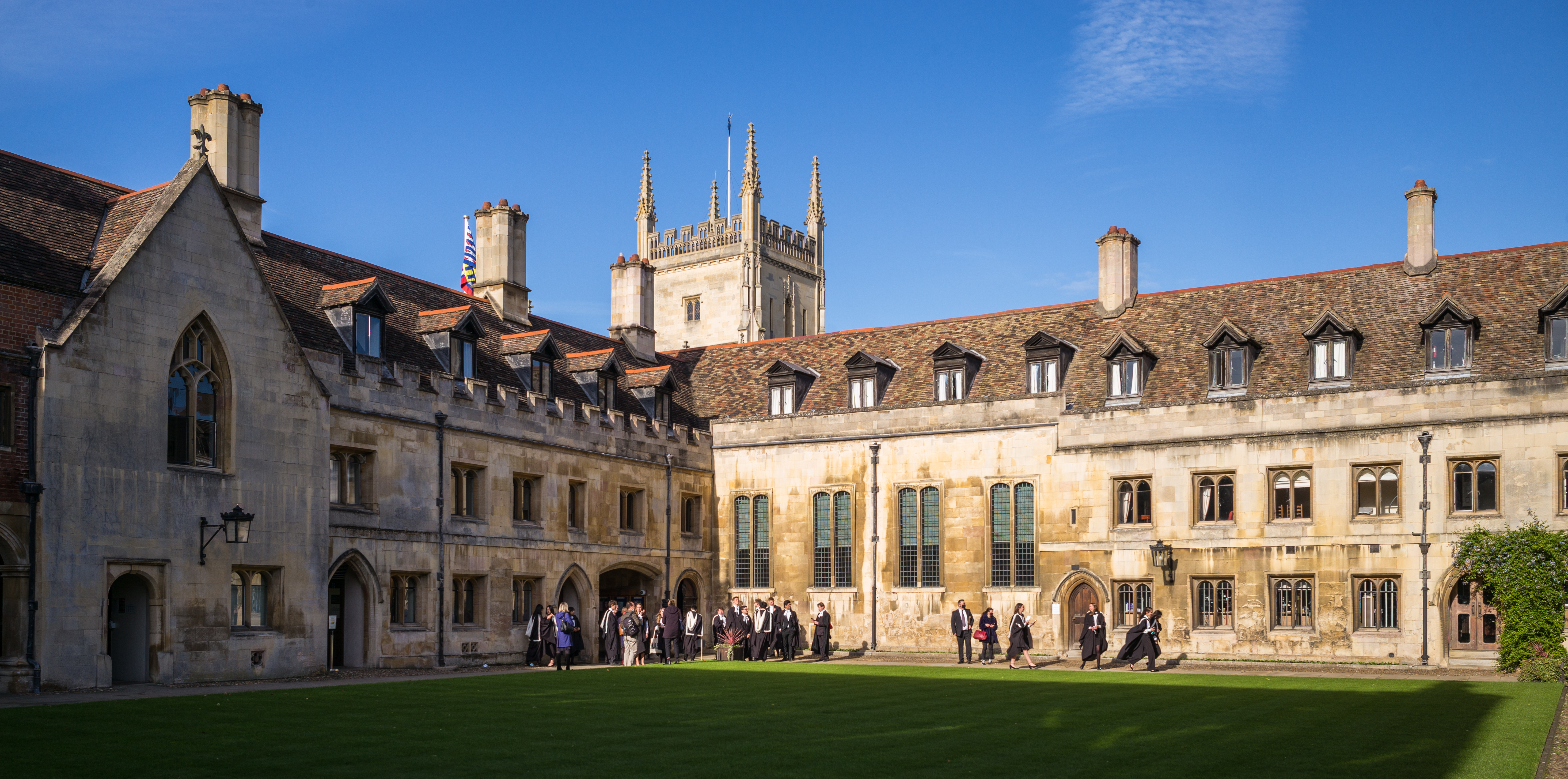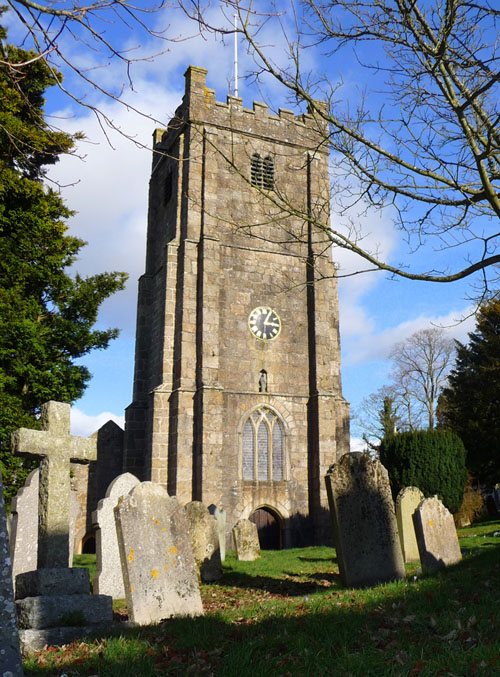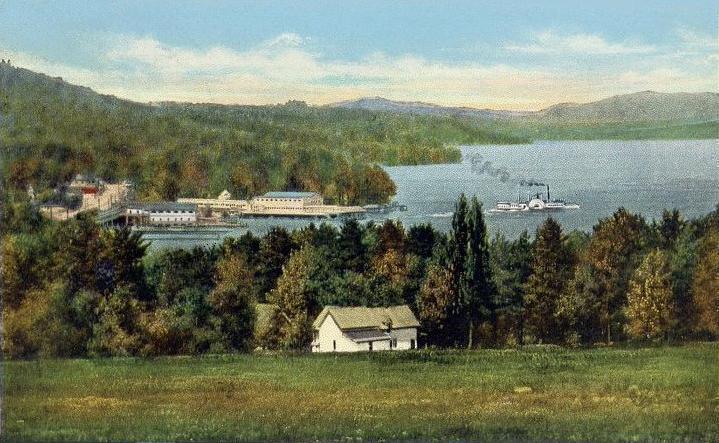|
John Endecott
John Endecott (also spelled Endicott; before 1600 – 15 March 1664/1665), regarded as one of the Fathers of New England, was the longest-serving governor of the Massachusetts Bay Colony, which became the Commonwealth of Massachusetts. He served a total of 16 years, including most of the last 15 years of his life. When not serving as governor, he was involved in other elected and appointed positions from 1628 to 1665 except for the single year of 1634. Endecott was a zealous and somewhat hotheaded Puritan, with Separatist attitudes toward the Anglican Church. This sometimes put him at odds with Nonconformist views that were dominant among the colony's early leaders, which became apparent when he gave shelter to the vocally Separatist Roger Williams. Endecott also argued that women should dress modestly and that men should keep their hair short, and issued judicial decisions banishing individuals who held religious views that did not accord well with those of the Puritans. He n ... [...More Info...] [...Related Items...] OR: [Wikipedia] [Google] [Baidu] |
John Winthrop
John Winthrop (January 12, 1587/88 – March 26, 1649) was an English Puritan lawyer and one of the leading figures in founding the Massachusetts Bay Colony, the second major settlement in New England following Plymouth Colony. Winthrop led the first large wave of colonists from England in 1630 and served as governor for 12 of the colony's first 20 years. His writings and vision of the colony as a Puritan " city upon a hill" dominated New England colonial development, influencing the governments and religions of neighboring colonies. Winthrop was born into a wealthy land-owning and merchant family. He trained in the law and became Lord of the Manor at Groton in Suffolk. He was not involved in founding the Massachusetts Bay Company in 1628, but he became involved in 1629 when anti-Puritan King Charles I began a crackdown on Nonconformist religious thought. In October 1629, he was elected governor of the Massachusetts Bay Colony, and he led a group of colonists to the New Worl ... [...More Info...] [...Related Items...] OR: [Wikipedia] [Google] [Baidu] |
Pequot
The Pequot () are a Native American people of Connecticut. The modern Pequot are members of the federally recognized Mashantucket Pequot Tribe, four other state-recognized groups in Connecticut including the Eastern Pequot Tribal Nation, or the Brothertown Indians of Wisconsin.Pritzker, Barry (2000) ''A Native American Encyclopedia: History, Culture, and Peoples'', pp. 656–657. Oxford University Press. . They historically spoke Pequot, a dialect of the Mohegan-Pequot language, which became extinct by the early 20th century. Some tribal members are undertaking revival efforts. The Pequot and the Mohegan were formerly a single group, but the Mohegan split off in the 17th century as the Pequot came to control much of Connecticut. Simmering tensions with the New England Colonies led to the Pequot War of 1634–1638, which dramatically reduced the population and influence of the Pequot; many members were killed, enslaved, or dispersed. Small numbers of Pequots remained in Connecti ... [...More Info...] [...Related Items...] OR: [Wikipedia] [Google] [Baidu] |
Julian Calendar
The Julian calendar, proposed by Roman consul Julius Caesar in 46 BC, was a reform of the Roman calendar. It took effect on , by edict. It was designed with the aid of Greek mathematicians and astronomers such as Sosigenes of Alexandria. The calendar became the predominant calendar in the Roman Empire and subsequently most of the Western world for more than 1,600 years until 1582, when Pope Gregory XIII promulgated a minor modification to reduce the average length of the year from 365.25 days to 365.2425 days and thus corrected the Julian calendar's drift against the solar year. Worldwide adoption of this revised calendar, which became known as the Gregorian calendar, took place over the subsequent centuries, first in Catholic countries and subsequently in Protestant countries of the Western Christian world. The Julian calendar is still used in parts of the Eastern Orthodox Church and in parts of Oriental Orthodoxy as well as by the Berbers. The Julian calenda ... [...More Info...] [...Related Items...] OR: [Wikipedia] [Google] [Baidu] |
Roger Williams (theologian)
Roger Williams (21 September 1603between 27 January and 15 March 1683) was an English-born New England Puritan minister, theologian, and author who founded Providence Plantations, which became the Colony of Rhode Island and Providence Plantations and later the U.S. State of Rhode Island and Providence Plantations, now the State of Rhode Island. He was a staunch advocate for religious freedom, separation of church and state, and fair dealings with Native Americans. Williams was expelled by the Puritan leaders from the Massachusetts Bay Colony and established Providence Plantations in 1636 as a refuge offering what he termed "liberty of conscience". In 1638, he founded the First Baptist Church in America, in Providence. Williams studied the indigenous languages of New England and published the first book-length study of a native North American language in English. Early life Roger Williams was born in or near London between 1602 and 1606, with many historians citing 1603 as the pr ... [...More Info...] [...Related Items...] OR: [Wikipedia] [Google] [Baidu] |
Edward Coke
Edward is an English given name. It is derived from the Anglo-Saxon name ''Ēadweard'', composed of the elements '' ēad'' "wealth, fortune; prosperous" and '' weard'' "guardian, protector”. History The name Edward was very popular in Anglo-Saxon England, but the rule of the Norman and Plantagenet dynasties had effectively ended its use amongst the upper classes. The popularity of the name was revived when Henry III named his firstborn son, the future Edward I, as part of his efforts to promote a cult around Edward the Confessor, for whom Henry had a deep admiration. Variant forms The name has been adopted in the Iberian peninsula since the 15th century, due to Edward, King of Portugal, whose mother was English. The Spanish/Portuguese forms of the name are Eduardo and Duarte. Other variant forms include French Édouard, Italian Edoardo and Odoardo, German, Dutch, Czech and Romanian Eduard and Scandinavian Edvard. Short forms include Ed, Eddy, Eddie, Ted, Teddy and Ned. ... [...More Info...] [...Related Items...] OR: [Wikipedia] [Google] [Baidu] |
New England Historic Genealogical Society
The New England Historic Genealogical Society (NEHGS) is the oldest and largest genealogical society in the United States, founded in 1845. NEHGS provides family history services through its staff, original scholarship, website,The History of NEHGS educational opportunities, and research center. Today it has over 250,000 members and more than 90 staff and volunteers. Headquarters NEHGS is headquartered at 99–101 Newbury Street in Boston's neighborhood. NEHGS moved there in 1964 and it is the seventh location for the organization. The first three floors of NEHGS' present location were built as the headquarters of The New England Trust Company in 1928, designed by Ralph ...[...More Info...] [...Related Items...] OR: [Wikipedia] [Google] [Baidu] |
Stannary
A stannary was an administrative division established under stannary law in the English counties of Cornwall and Devon to manage the collection of tin coinage, which was the duty payable on the metal tin smelted from the ore cassiterite mined in the region. In Cornwall, the duty was passed to the Duchy of Cornwall; in Devon to the Crown. With the abolition of tin coinage in 1838 (following extensive petitioning by the Cornish tin industry for simplification of the taxation rules), the principal purpose of the stannaries ceased. In Cornwall, however, they retained certain historic rights to appoint stannators to the Cornish Stannary Parliament. Etymology The word ‘stannary’ is derived from the Middle English ''stannarie'', through Medieval Latin ''stannaria'' (‘tin mine’), ultimately from Late Latin ''stannum'' (‘tin’) (cf. the symbol for the chemical element Sn). The native Cornish word is ''sten'' and tin-workings ''stenegi''. In Cornwall There were four Cornish ... [...More Info...] [...Related Items...] OR: [Wikipedia] [Google] [Baidu] |
Devon
Devon ( , historically known as Devonshire , ) is a ceremonial and non-metropolitan county in South West England. The most populous settlement in Devon is the city of Plymouth, followed by Devon's county town, the city of Exeter. Devon is a coastal county with cliffs and sandy beaches. Home to the largest open space in southern England, Dartmoor (), the county is predominately rural and has a relatively low population density for an English county. The county is bordered by Somerset to the north east, Dorset to the east, and Cornwall to the west. The county is split into the non-metropolitan districts of East Devon, Mid Devon, North Devon, South Hams, Teignbridge, Torridge, West Devon, Exeter, and the unitary authority areas of Plymouth, and Torbay. Combined as a ceremonial county, Devon's area is and its population is about 1.2 million. Devon derives its name from Dumnonia (the shift from ''m'' to ''v'' is a typical Celtic consonant shift). During the Briti ... [...More Info...] [...Related Items...] OR: [Wikipedia] [Google] [Baidu] |
Chagford
Chagford is a market town and civil parish on the north-east edge of Dartmoor, in Devon, England, close to the River Teign and the A382, 4 miles (6 km) west of Moretonhampstead. The name is derived from ''chag'', meaning gorse or broom, and the ''ford'' suffix indicates its importance as a crossing place. At the 2011 Census, it had a population of 1,449. History Archaeological remains confirm that a community has existed here for at least 4000 years. In historical times, Chagford grew due to the wool trade and from tin mining in the area. A weekly market was held here from before 1220, and a monthly livestock market in the town survived until the 1980s. In 1305 it was made a stannary town where tin was traded. Among the most prominent tin-mining families in the 16th century were the Endecotts, Knapmans, Whiddons and Lethbridges. In an English Civil War skirmish Sidney Godolphin, the poet and Royalist MP for Helston, was shot and killed in the porch of the Three Crowns. In ... [...More Info...] [...Related Items...] OR: [Wikipedia] [Google] [Baidu] |
Roper Lethbridge
Sir Roper Lethbridge (23 December 1840 – 15 February 1919) was a British academic and civil servant in India and a Conservative Party politician who sat in the House of Commons from 1885 to 1892. Early life and education Lethbridge was the son of E. Lethbridge of Ste. Addresse, France. He was educated at Exeter College, Oxford and entered Inner Temple in 1864. Career He was appointed a Professor in the Bengal Educational Department in 1868, and became a Fellow of University of Calcutta and Secretary of Simla Educational Commission. He was Editor of the ''Calcutta Quarterly Review'' from 1871 to 1878. In 1877, he moved to the Indian Political Department as Political Agent, 1st class, and was appointed Press Commissioner in 1878 when he was awarded Companion of the Indian Empire. He was knighted in 1885. Lethbridge was Hon. Member of the Anjuman-i-Punjab, a Member of the Asiatic Society and the Asiatic Society of Bengal and a Member of Council of East Indian Association and ... [...More Info...] [...Related Items...] OR: [Wikipedia] [Google] [Baidu] |
Dorchester, Dorset
Dorchester ( ) is the county town of Dorset, England. It is situated between Poole and Bridport on the A35 trunk route. A historic market town, Dorchester is on the banks of the River Frome to the south of the Dorset Downs and north of the South Dorset Ridgeway that separates the area from Weymouth, to the south. The civil parish includes the experimental community of Poundbury and the suburb of Fordington. The area around the town was first settled in prehistoric times. The Romans established a garrison there after defeating the Durotriges tribe, calling the settlement that grew up nearby Durnovaria; they built an aqueduct to supply water and an amphitheatre on an ancient British earthwork. After the departure of the Romans, the town diminished in significance, but during the medieval period became an important commercial and political centre. It was the site of the "Bloody Assizes" presided over by Judge Jeffreys after the Monmouth Rebellion, and later the trial of t ... [...More Info...] [...Related Items...] OR: [Wikipedia] [Google] [Baidu] |
Lake Winnipesaukee
Lake Winnipesaukee () is the largest lake in the U.S. state of New Hampshire, located in the Lakes Region at the foothills of the White Mountains. It is approximately long (northwest-southeast) and from wide (northeast-southwest), covering — when Paugus Bay is included—with a maximum depth of . The center area of the lake is called The Broads. The lake contains at least 264 islands, half of which are less than in size, and is indented by several peninsulas, yielding a total shoreline of approximately . The driving distance around the lake is . It is above sea level. Winnipesaukee is the third-largest lake in New England after Lake Champlain and Moosehead Lake. Outflow is regulated by the Lakeport Dam in Lakeport, New Hampshire, on the Winnipesaukee River. History The Abenaki name ''Winnipesaukee'' (often spelled Winnipiseogee in earlier centuries) means either "smile of the Great Spirit" or "beautiful water in a high place". At the outlet of the lake, th ... [...More Info...] [...Related Items...] OR: [Wikipedia] [Google] [Baidu] |



_(cropped).jpg)


